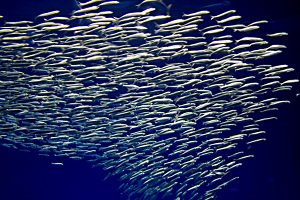 Pacific sardines at the Monterey Bay Aquarium. Photo: Adventures in Librarianship.
Pacific sardines at the Monterey Bay Aquarium. Photo: Adventures in Librarianship.
It’s back to school—for students, and for Pacific sardines. Pacific sardines, Sardinops sagax, were once wildly abundant along the coast of California, Oregon, and Washington. From the 1920s to through the 1940s, they supported the largest fishery in the United States—millions were caught in and around Monterey Bay. (In fact, the Monterey Bay Aquarium was once a sardine canning factory.) Though the Pacific sardine population crashed in the mid-1940s, it’s on the rise again.
While overfishing may have played a role in the population crash in the 1940s, oceanographic conditions were also very influential. The size of the Pacific sardine population fluctuates; their numbers increase when water is warm, and decrease when water is cold. This has been happening for quite some time; fish scales from sediments in the Santa Barbara Basin show that the sardines have been going through a boom-and-bust cycle for the past 1700 years.
In recent years, Pacific sardine numbers have been increasing steadily. Fishing started up again in California in the 1980s; by 2000, fisheries had been re-established off the coasts of Oregon and Washington, too. These days, Pacific sardines are doing fine. The Monterey Bay Aquarium’s Seafood Watch Guide lists sardines as a “best choice.”
However, another schooling fish, Atlantic Herring isn’t doing quite as well. Many species of schooling fish are caught not for human consumption, but to feed poultry, livestock, and fish in the aquaculture industry. They’re processed into fishmeal and fish oil. This is a bit of a problem. Schooling fish (called clupeoid fish, for all of you aficionados) are an important part of the food web. They eat plankton, and in turn are eaten by larger predatory fish, marine mammals, and birds. Taking schooling fish out of the ocean, so they can be food for our other food, has serious repercussions for the marine food web.
